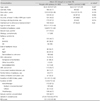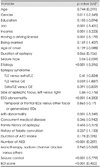1. Calvocoressi L, Libman D, Vegso SJ, McDougle CJ, Price LH. Global functioning of inpatients with obsessive-compulsive disorder, schizophrenia, and major depression. Psychiatr Serv. 1998; 49:379–381.

2. Kessler RC, Berglund P, Demler O, Jin R, Merikangas KR, Walters EE. Lifetime prevalence and age-of-onset distributions of DSM-IV disorders in the National Comorbidity Survey Replication. Arch Gen Psychiatry. 2005; 62:593–602.

3. Stein DJ. Obsessive-compulsive disorder. Lancet. 2002; 360:397–405.

4. Skoog G, Skoog I. A 40-year follow-up of patients with obsessive-compulsive disorder [see commetns]. Arch Gen Psychiatry. 1999; 56:121–127.

5. Modell JG, Mountz JM, Curtis GC, Greden JF. Neurophysiologic dysfunction in basal ganglia/limbic striatal and thalamocortical circuits as a pathogenetic mechanism of obsessive-compulsive disorder. J Neuropsychiatry Clin Neurosci. 1989; 1:27–36.
6. Tizard B. The personality of epileptics: a discussion of the evidence. Psychol Bull. 1962; 59:196–210.

7. Isaacs KL, Philbeck JW, Barr WB, Devinsky O, Alper K. Obsessive-compulsive symptoms in patients with temporal lobe epilepsy. Epilepsy Behav. 2004; 5:569–574.

8. Monaco F, Cavanna A, Magli E, Barbagli D, Collimedaglia L, Cantello R, et al. Obsessionality, obsessive-compulsive disorder, and temporal lobe epilepsy. Epilepsy Behav. 2005; 7:491–496.

9. Ertekin BA, Kulaksizoğlu IB, Ertekin E, Gürses C, Bebek N, Gökyiğit A, et al. A comparative study of obsessive-compulsive disorder and other psychiatric comorbidities in patients with temporal lobe epilepsy and idiopathic generalized epilepsy. Epilepsy Behav. 2009; 14:634–639.

10. de Oliveira GN, Kummer A, Salgado JV, Portela EJ, Sousa-Pereira SR, David AS, et al. Psychiatric disorders in temporal lobe epilepsy: an overview from a tertiary service in Brazil. Seizure. 2010; 19:479–484.

11. Hamed SA, Elserogy YM, Abd-Elhafeez HA. Psychopathological and peripheral levels of neurobiological correlates of obsessive-compulsive symptoms in patients with epilepsy: a hospital-based study. Epilepsy Behav. 2013; 27:409–415.

12. Kulaksizoglu IB, Bebek N, Baykan B, Imer M, Gürses C, Sencer S, et al. Obsessive-compulsive disorder after epilepsy surgery. Epilepsy Behav. 2004; 5:113–118.

13. Park SP, Song HS, Hwang YH, Lee HW, Suh CK, Kwon SH. Differential effects of seizure control and affective symptoms on quality of life in people with epilepsy. Epilepsy Behav. 2010; 18:455–459.

14. Kwon OY, Park SP. What is the role of depressive symptoms among other predictors of quality of life in people with well-controlled epilepsy on monotherapy? Epilepsy Behav. 2011; 20:528–532.

15. Proposal for revised clinical and electroencephalographic classification of epileptic seizures. From the Commission on Classification and Terminology of the International League Against Epilepsy. Epilepsia. 1981; 22:489–501.
16. Commission on Classification and Terminology of the International League Against Epilepsy. Proposal for classification of epilepsies and epileptic syndromes. Epilepsia. 1985; 26:268–278.
17. Perucca P, Mula M. Antiepileptic drug effects on mood and behavior: molecular targets. Epilepsy Behav. 2013; 26:440–449.

18. Min BB, Won HT. Reliability and validity of the Korean translations of Maudsley Obsessional-Compulsive Inventory and Pauda Inventory. Korean J Clin Psychol. 1999; 18:163–182.
19. Rhee MK, Lee YH, Jung HY, Choi JH, Kim SH, Kim YK, et al. A standardization study of Beck Depression Inventory 2: Korean version (K-BDI): validity. Korean J Psychopathol. 1995; 4:96–104.
20. Yoo HJ, Lee SA, Heo K, Kang JK, Ko RW, Yi SD, et al. The reliability and validity of Korean QOLIE-31 in patients with epilepsy. J Korean Epilepsy Soc. 2002; 6:45–52.
21. Annegers JF, Hauser WA, Elveback LR. Remission of seizures and relapse in patients with epilepsy. Epilepsia. 1979; 20:729–737.

22. Hitiris N, Mohanraj R, Norrie J, Sills GJ, Brodie MJ. Predictors of pharmacoresistant epilepsy. Epilepsy Res. 2007; 75:192–196.

23. First MB, Spitzer RL, Gibbon M, Williams JB. Structured Clinical Interview for DSM-V-TR Axis I Disorders. Non-Patient Edition. New York: Biometrics Research Department;2001.
24. Jones JE, Hermann BP, Barry JJ, Gilliam F, Kanner AM, Meador KJ. Clinical assessment of Axis I psychiatric morbidity in chronic epilepsy: a multicenter investigation. J Neuropsychiatry Clin Neurosci. 2005; 17:172–179.

25. Mataix-Cols D, Fullana MA, Alonso P, Menchón JM, Vallejo J. Convergent and discriminant validity of the Yale-Brown Obsessive-Compulsive Scale Symptom Checklist. Psychother Psychosom. 2004; 73:190–196.

26. Tellez-Zenteno JF, Patten SB, Jetté N, Williams J, Wiebe S. Psychiatric comorbidity in epilepsy: a population-based analysis. Epilepsia. 2007; 48:2336–2344.

27. Murphy DL, Timpano KR, Wheaton MG, Greenberg BD, Miguel EC. Obsessive-compulsive disorder and its related disorders: a reappraisal of obsessive-compulsive spectrum concepts. Dialogues Clin Neurosci. 2010; 12:131–148.








 PDF
PDF ePub
ePub Citation
Citation Print
Print





 XML Download
XML Download